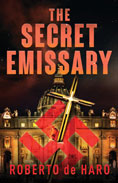
 |
Born into a wealthy Mexican family around 1900, Luis Valderano admires and has learned much from his older brother, Ruben. The two enjoy life on their family’s large ranch, although it does come with complications from their older stepbrother, Elpidio, who is heir to the estate and more connected to his deceased mother’s family than their own. Ruben eventually moves to Spain near his mother’s family for schooling and begins taking an interest in military service. After showing an interest in Catholicism, Luis is put under the guidance of Brother Tracy. This begins a period of intense educational and religious training, which will lead Luis to dedicate his life to the priesthood. His intellect and devotion, as well as the influence his family’s wealth brings, opens many doors for Luis. Both Ruben and Luis serve in their respective disciplines with distinction, growing in reputation and responsibility. The coming of WWII finds the brothers with ties to wealthy and influential men on both sides of the Atlantic, and they each battle the Axis powers. Although the Vatican officially stays neutral, Luis secretly works with many underground groups to help refugees, resistance fighters, and secret agents.
Author of more than a dozen books, de Haro typically writes action and adventure stories. In this work, he takes a different approach and gives a first-person account of Luis. This character-driven portrait is a fascinating look into what may drive someone to commit themselves to the cloth and the ways in which an individual can make a real difference in wartime without being on the frontlines. The setting and first-person account are reminiscent of Kristin Hannah’s The Nightingale in that both works are set in the same time period, have a first-person point of view, and deal with secretly resisting fascism under the threat of great peril and death. In another way, the work parallels a seemingly unrelated, non-fiction work titled Poets in Their Youth by Eileen Simpson. In both works, the central character tells their story, which is intertwined with the lives of famous figures from history. Luis meets countless presidents, military leaders, etc., in his work through the church and his resistance efforts. In comparison, Simpson is part of the circle of literary figures such as John Berryman, Delmore Schwartz, and Robert Lowell.
Additionally, as de Haro’s characters are intimately involved with the influential powers both in Europe and the Americas throughout the early twentieth century, the reader is given a historian’s account of the events, political aspirations, and mistakes that led to WWII. The author’s research into and knowledge of the period shows a solid understanding of the social, economic, and political components of that great conflagration. As a writer, de Haro’s lengthy experience has brought him to this point where he can write large, historical fiction focused on character depth and the global positions of many countries and entities while maintaining the reader's interest. There are a couple of places where details are repeated and characters surrounding Luis feel more interesting than the protagonist, but Luis’ faith, strength of character, cunning, and bravery keep him the central figure and object of the reader’s engagement. This book is easy to recommend to anyone interested in the period involving the two world wars, as well as to those who love a deep dive into the development and motivations of a fascinating protagonist.
RECOMMENDED by the US Review